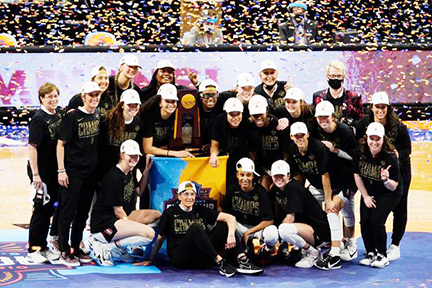NASHVILLE, TN — After top-seeded Stanford narrowly squeezed by South Carolina 66-65 in the Final Four, few thought it would be possible for the title game to be anywhere near as exciting whether their rival was Arizona or longtime champion UConn. But those expectations were more than met by Sunday’s thrilling 54-53 title win over Arizona. The Baylor/Gonzaga men’s final will have to really be a classic to equal the drama of this one that saw once again Stanford survive a final-second attempt and get their first NCAA Women’s Tournament victory since 1992.
by Sunday’s thrilling 54-53 title win over Arizona. The Baylor/Gonzaga men’s final will have to really be a classic to equal the drama of this one that saw once again Stanford survive a final-second attempt and get their first NCAA Women’s Tournament victory since 1992.
Stanford also became the first team in the history of either the men’s or women’s events to get consecutive one-point victories in the Final Four. It was Tara Vanderveer’s third championship. The all Pac-12 final was also the first for the conference in either men’s or women’s basketball history and concluded a whirlwind season that saw Stanford able to survive a year when they had to play two months of their games on the road due to COVID-19 protocols in Santa Clara county.
“Getting through all the things we got through, we’re excited to win the COVID championship,” VanDerveer said on ESPN. “The other one was not quite as close, the last one. But we’re really excited. No one knows the score, no one knows who scored, it’s a national championship and I’m really excited to represent Stanford. It’s a great team. We did not play a great game today, however. But if we can win, not playing as well as we need to, I’m excited.”
The event was also historic in terms of achievements by Black women’s coaches. It was the first time two Black women head coaches reached the Final Four, and while both South Carolina’s Dawn Staley and Arizona’s Adia Barnes saw their clubs lose one-pointers in the final seconds, it didn’t take anything away from their achievement. Staley has already won one title, while Barnes took Arizona to its first title game ever. Their previous best finish had been a spot in the Sweet 16.
“This team is so special,” Barnes said. “I am so proud. We fought. We weren’t the best team in the tournament. No one thought we’d be here. We believed in each other. We didn’t play a great game, but we battled. We played our hearts out. We came within one possession.”
This Tournament will also possibly be seen as the one that finally forces some long-awaited, necessary changes in detail and attention regarding the women’s event. It made absolutely no sense for the two tournaments to be competing head-to-head most of the time, pandemic or not.
While the men’s event was being televised on four different networks and being showcased all over Indianapolis, both players and media representatives spotlighted the fact the courts in San Antonio didn’t even have the NCAA Women’s Tournament logo prominently shown much of the time. The facilities disparity was also shockingly evident, most notably the appalling workout facilities and equipment provided the women players.
Calls for the firing of NCAA head Mark Emmert, who’s held his position over a decade, were loud and lengthy throughout the Women’s Tournament. He initially tried to explain the disparities, but later acknowledged that the women had been shortchanged. Despite the attitude of those in power, this year’s NCAA Women’s Tournament was spectacular in terms of on-court basketball. Hopefully by next year the caliber of publicity, exposure and resources they receive from the NCAA will match the efforts of the athletes.

